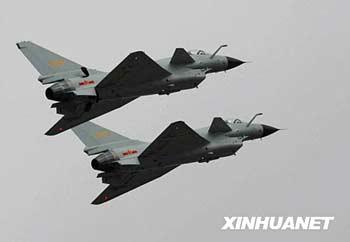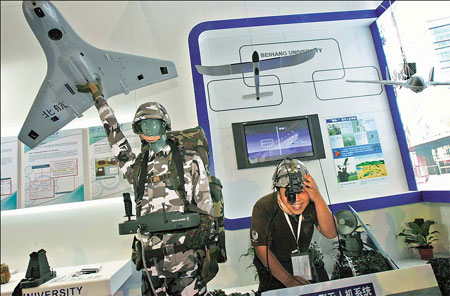
The dazzling debut of Chinese-made fighter jets started the
second day's aerial display at the Zhuhai air show.

An exhibitor at the aviation show in Zhuhai demonstrates a made-in-China Unmanned Aerial Vehicle. The hi-tech piece of kit is designed to carry heavy weapons but can be operated by a single soldier. [Agencies]
Translation: Chinese » English
中購入281架俄戰機【特派員林寶慶華盛頓報導】最新一期「漢和防務評論」報導,中國正在自己設計航母艦載戰機,最可能上艦的戰機是殲10A和殲11的海軍型,將來可能需要俄羅斯造Su-33艦載戰機或技術。「漢和防務評論」指出,俄羅斯蘇霍伊飛機公司,已向中國空軍交付281架Su-27SK/UBK和Su-30MKK/MK2戰機,其中105架 Su27SK/J11戰機係由中國組裝。報導說,世界上使用蘇霍伊戰機最多的是中國空軍。漢和說,目前中國空軍擁有48架Su-27SK/UBK戰機、28架Su-27-UBK教練機。此外還接收了76架Su-30MKK雙座多用途戰機,而中國海軍航空兵進口了24架改裝型Su-30MK2戰機。後者的航電系統和指導武器系統具備更強的作戰能力。上述俄式戰機已經分別裝備空軍第1、2、3 、6、18、19、29、7、33、14殲擊機師以及海航第4師。報導說,由於中國已啟動了航空母艦建造計畫,將來可能需要俄羅斯造Su-33艦載戰機或技術。漢和防務評論總編輯平可夫說,種種跡象顯示,中國正在自己設計艦載戰機,最可能上艦的飛機是殲10A和殲11的海軍型。為此中國已經從俄羅斯購買了Su- 33戰機使用的著艦尾勾等技術。他說,中國海軍人員近期頻繁訪問烏克蘭克里米亞的航母艦載機飛行員訓練中心。漢和判斷,中國即將建設陸上航母飛行員模擬訓練基地。
China to buy 281 Russian fighter
Lin Baoqing Washington correspondent 【】 reports the latest issue of "Chinese and defense review" reports that China is designing its own aircraft carrier-based warplanes, most likely on the ship is the F-10A fighter and the Navy F-11, may be necessary in the future Russia-made Su-33 carrier-based Or technical fighter.
"Han and defense review," pointed out that Russia's Sukhoi aircraft, Air China has delivered 281 planes Su-27SK/UBK and Su-30MKK/MK2, of which 105 fighters Su27SK/J11 by the Chinese assembly line.
Reported that the use of Sukhoi fighters in the world is China's largest air force.
Han and said that the Chinese Air Force currently has a 48 Su-27SK/UBK fighters, 28 Su-27-UBK trainer. In addition, to receive the 76 Su-30MKK multi-purpose two-seater fighter, and the import of Chinese naval air force 24-modified Su-30MK2 fighters. The latter's avionics systems and weapons guidance systems have greater combat capability. The above-mentioned Russian Air Force planes have been equipped with 1, 2, 3, the fighters 6,18,19,29,7,33,14 division, as well as Article 4 of the naval air division.
Report said that because China has launched a project to build an aircraft carrier, may be necessary in the future Russia-made Su-33 carrier-based warplanes or technology.
Chinese defense review and editor-in-chief Andrei Pinkov, said all the indications that China is designing its own carrier-based warplanes, most likely on the ship's aircraft are F-10A and F-11 Navy. To this end, China has purchased from Russia Su-33 fighter planes to use the book hook Jianwei, and other technology.
He said that the Chinese naval officers have been frequent recent visit to Ukraine's Crimean carrier-based aircraft carrier pilot training center. Han and the judge, the building of China is about to land the aircraft carrier pilot simulation training base.
LPD and LHD
Spotlight On PLA Navy's New LPD and LHD
By Prasun K. Sengupta
China's PLA Navy (PLAN) on July 6 commissioned its first of six Type 071 Landing Platform Docks (LPD) that will be used for both tri-services operational logistics as well as civilian disaster relief operations. The vessel, with pennant number 998, is now operational with the Navy's South Sea Fleet and has on board four Z-8K heavylift helicopters. The state-owned China State Shipbuilding & Trading Corp (CSTC), a subsidiary of the China State Shipbuilding Corp (CSSC), had on December 21, 2006 launched the first LPD at its Shanghai-based Hudong Zhonghua Shipbuilding facility and this vessel early last September began her sea trials. A modified variant of the Type 071 LPD is also being offered for export to Malaysia by CSTC, which is leading a formidable consortium of Chinese companies that will include China North Industries Corp (NORINCO), China Electronics Trading Corp International (CETC), and guided-missile manufacturer China National Precision Machinery Import-Export Corp (CPMIEC) in its bid to win the Malaysian contract. The Royal Malaysian Navy has projected a requirement for at least two such LPDs, which it calls the multi-role support ship (MRSS).
.
http://www.indiadefenceupdate.com/news128.html
PLA navy
Naval Industry: China operates a vibrant commercial and naval shipbuilding industry that is globally competitive. China is the third-largest shipbuilder in the world, after Japan and South Korea. Shipyard modernization and expansion has increased China’s overall shipbuilding capacity and capabilities, generating corresponding benefits for all types of naval projects, including submarines; surface combatants; naval aviation, including initiatives for aircraft carriers; and amphibious/sealift-airlift assets. China continues to rely on foreign suppliers for some propulsion units and, to a lesser degree, fire control systems, cruise missiles, ship-to-air missiles, torpedo systems, sensors, and other advanced electronics. Modular shipbuilding techniques will allow China to spread production across multiple locations, increasing both efficiency and the number of ships that can be simultaneously produced. China has already demonstrated an ability to surge submarine and amphibious ship production.
http://www.globalsecurity.org/military/library/report/2008/2008-prc-military-power05.htm
Chicom restructures its aerospace sector
China restructures its aerospace sector
By Leithen Francis
China has begun to make some of the biggest changes in decades to its state-run aerospace sector and has set it big goals as Beijing seeks to make an impact on the international aviation stage.
The country has embarked on a mission to become a world-class aircraft-maker with a line-up of world-beating aviation products such as a 150-seat commercial jet aircraft. To help it achieve this aim Beijing has merged the country's two aviation industry conglomerates Aviation Industry Corporation I and II.
Once a single entity, they were divided in 1999 because it was thought splitting the company into two would boost competition and as a consequence drive efficiencies. Now the two are coming together again because the government has realised that operating the two separately split resources and led to redundant projects.
ACAC ARJ21 TBB/Flight
© Tim Bicheno-Brown/ Flight International
Merging the two creates a conglomerate with more than 420,000 employees spread across more than 100 companies. Subsidiaries in the group include manufacturing plants and research institutes involved in making Chinese civil and military aircraft, parts for Western aircraft makers and even production of Chinese cars and buses. The future success of AVIC is important to China because it makes military aircraft as well as commercial aircraft.
Industry sources in China say the merged entity will be structured into five main businesses. These will include an air transport manufacturing, helicopter, aviation engines and systems company. The restructure means the businesses are based on areas of expertise, allowing AVIC to create centres of excellence and draw on skills across the country.
COMMERCIAL JET DEVELOPMENT
Besides merging the two AVICs, the Chinese central government has created a new company, Commercial Aircraft Corporation of China (Comac), to oversee development of the 150-seat commercial jet. Comac's biggest single shareholder is the state-owned Assets Supervision and Administration Commission of the state council.
AVIC is the next major shareholder and the others are the Shanghai government, Aluminium Corporation of China and steel producer Baosteel.
Even though AVIC is a major shareholder, Comac stands apart from AVIC and in the pecking order of state-owned enterprises ranks higher, reporting direct to the Assets Supervision and Administration Commission rather than to AVIC.
The reason for its high standing is the people who head it. Comac's chairman is Zhang Qingwei, previously minister of China's Commission of Science Technology and Industry for National Defence (COSTIND). President Jin Zhuanglong was a vice minister of COSTIND and both are standing committee members of the Communist Party Congress.
AVIC is much larger in terms of assets, but the businesses Comac has are significant and industry insiders say its asset base will grow - its current assets are AVIC 1 Commercial Aircraft (ACAC), Shanghai Aircraft (SAC) and First Aircraft Institute (FAI).
FAI is based in Xian and has a branch in Shanghai. It is the country's leading design institute for commercial aircraft. ACAC is the Shanghai firm that oversees the ARJ21 regional jet programme and SAC performs the ARJ21 final assembly.
http://www.flightglobal.com/articles/2008/10/28/317953/china-restructures-its-aerospace-sector.html





No comments:
Post a Comment